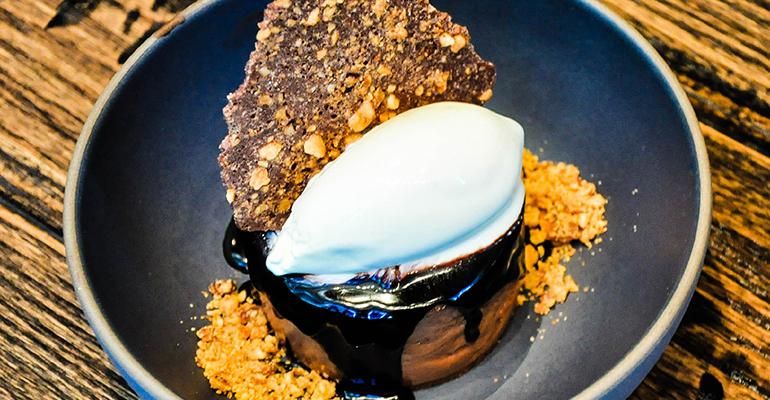Seven years ago, Nation’s Restaurant News looked ahead to the year 2020 to see where restaurant menus might be headed.
We correctly predicted that people would be ordering for and paying for their food on their phones.
“Restaurant patrons are already accustomed to reading menus online, but as the smartphone and tablet revolution continues, they also will expect the ability to order and pay for their food from their handheld devices,” we said. We also predicted that they’d be able “to sort the menu items according to nutritional value or price.”
Certainly consumers are ordering and paying for their food using their smartphones, and they can (and do) customize those orders with ease, but the automatic sorting we predicted hasn’t really happened. We got this about 90% right.
Discover Ron Ruggless' analysis of restaurant predictions here.
We also predicted this: “As restaurant patrons grow increasingly used to customizing their own food, most chefs will give up on the idea of offering center-of-the-plate items accompanied by appropriate sides in favor of à la carte ordering.”
This happened, but a bit differently than expected. Infinite customization has certainly become more widespread, and many new full-service restaurants are more focused on smaller, shareable plates rather than composed ones. This was about 80% right.
As for restaurants themselves, we said, “Rising real estate, labor and food costs will result in smaller, more cuisine-focused restaurants with many stock-keeping units, or SKUs, used in multiple preparations. A growing number of restaurants probably will outsource their desserts for those same reasons.”
 Restaurants have definitely upsized their efficiency and downsized their menus, and we’re seeing more desserts that are not only outsourced, but often co-branded with their suppliers — particularly Oreos, although Cinnabon has a robust co-branding business, too. 100%
Restaurants have definitely upsized their efficiency and downsized their menus, and we’re seeing more desserts that are not only outsourced, but often co-branded with their suppliers — particularly Oreos, although Cinnabon has a robust co-branding business, too. 100%
We expected surge pricing to happen on menus. “With no paper menus, restaurants will be able to adjust their prices in real time, changing them daily or even hourly by the penny, if they like,” we said.
We maintain that this is a great idea, but with a few exceptions, such as restaurants that sell tickets to their dining experiences with different prices based on demand, this hasn’t happened. We get about 10% for this one.
“Don’t let the [simple menu descriptions on smart-phone menus] fool you. Lengthier descriptions will be available with the tap of a finger, including links to more information about the origins of proteins and any local ingredients and suppliers.”
This is about 90% right. Links to lengthier descriptions, and nutritional information, are pretty commonplace, but we haven’t seen as much use of links to suppliers, or videos of the farms, ranches or boats that are making the ingredients. We think there’s still great opportunity there.
We also predicted some dishes that we’d see more of, as indications of broader trends:
Ghana Chicken-Peanut Curry: “The national dish of Ghana, the actual name is Nkatenkwan, but restaurateurs will find a more easily digestible term. The dish is a natural extension of the trend toward slightly unusual presentations of familiar ingredients.” 100%
We got this trend right, and we get bonus points for the slow but growing influx of West African dishes onto menus. By the way, you can get a vegetarian version of Nkatenkwan at Pura Vida in Cleveland, where it’s called African Peanut Stew.
Tandoori Chicken: “Indian cuisine has long been an also-ran in the world of food trends, but India’s growing economic prominence and global influence will lend appeal to the country and possibly give it a stronger presence on menus, probably starting with straightforward items such as this one.” 90%
Indian food is creeping into the mainstream, particularly with some small fast-casual concepts like Biju’s Little Curry Shop, Curry Up Now and Kathi Roll Company. Creative operators, like Maneet Chauhan in Nashville and Nakul and Arjun Mahendro in Los Angeles, are taking the cuisine out of strip malls and closer to the mainstream, and influential Indian chefs such as Srijith Gopinathan of Campton Place in San Francisco are bringing the flavors of the sub-continent into fine dining. It still hasn’t really burst onto the scene, but it’s making progress.
Millet and Callaloo Salad: “Whole grains and greens are here to stay, but as quinoa and kale become mainstream, other varieties will trend in and out. Millet is gluten free, high in fiber and was widely eaten in the ancient world. Callaloo, the leaf of the taro plant, is a popular green in the Caribbean.” 80%
“Ancient grains” is the term for millet and its cousins, which are now pretty widespread on menus. Kale, however, has shown remarkable staying power, and although we’ve seen a proliferation of different leafy greens, kale still dominates.
Feijoada: “This Brazilian bean stew with pork has a low food cost and will appeal to customers who have taken a liking to Brazil, whose global cachet will be enhanced by its hosting of the World Cup in 2014 and the Olympics in 2016.” 60%
We’ve seen more Brazilian restaurants opening in recent years, but the focus on Brazil during the Olympics had more to do with the questionable facilities and Ryan Lochte’s shenanigans than the culture, or food, itself.
Green Crab Bisque: “Green crab is a small crustacean that’s considered a nuisance in the Atlantic Ocean and suitable only for bait because the animals are too small for the meat to be extracted effectively. However, their high shell-to-meat ratio makes for a rich crabby flavor that can work well in a bisque. As restaurateurs continue to look for sustainable seafood sources, species such as these that were previously shunned will become more attractive.” 90%
Green crab has, indeed, popped up on menus in New England, and other invasive species, such as blue catfish and lionfish, are being offered in other parts of the country.
Asian Carp Ceviche: “Another invasive species — bony but tasty — it makes a fine ceviche. Ceviche and other Latin American preparations will be more prevalent owing to demographic shifts.” 90%
An increase in Latin cuisines, definitely, including ceviche. Asian carp, not so much.
Las Vegas Strip Steak: “As beef prices continue to rise, new cuts will be isolated in cattle. Consider the Las Vegas Strip. The name was given to the subscapularis muscle by the scientist who patented the process for isolating it. It lies between the shoulder blade and the backbone, and is reportedly as tender as the New York Strip.” 20%

Hamburger: “America’s favorite menu item is expected to remain America’s favorite menu item.” 100%
This one speaks for itself.
Contact Bret Thorn at [email protected]
Follow him on Twitter: @foodwriterdiary





